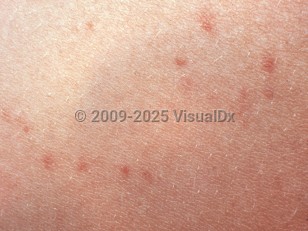Enteric fever
Alerts and Notices
Important News & Links
Synopsis

Typhoid and paratyphoid fevers (enteric fever) occur from infection with Salmonella enterica serotype typhi and Salmonella enterica serotype paratyphi A, B, and C, respectively. These infections are found in most parts of the world, with lower rates in industrialized regions (United States, Canada, Western Europe, and Japan). Unlike nontyphoidal Salmonella, typhoid and paratyphoid are strictly human diseases and transmitted via fecal-oral transmission between humans. Typhoid and paratyphoid are clinically indistinguishable from each other, and the term "enteric fever" is used as a unifying term to encompass both conditions.
The incubation period for typhoid fever is 6-30 days, and for paratyphoid fever it is 1-10 days. The initial symptoms of typhoid and paratyphoid fevers include the acute or gradual onset of abdominal pain and tenderness, fever, chills, sweating, headache, anorexia, weakness, cough, sore throat, dizziness, and myalgias. Fever develops slowly beginning as low-grade and rising to sustained temperatures of 102°F-104°F (39°C-40°C) by the fourth day. This usually progresses to a severe illness with bacteremia and high fever that may last for weeks. Hepatosplenomegaly is common. Some patients will develop erythematous macules and papules on the trunk ("rose spots"), and some will suffer altered mental status. Intestinal hemorrhage and bowel perforation are rare, potentially lethal complications that may occur after 2 weeks of illness. Meningitis, chondritis, cholecystitis, pyelonephritis, orchitis, typhoid hepatitis, pneumonia, localized abscesses, endocarditis, and myocarditis are further rare complications.
About 350 culture-confirmed cases of typhoid fever and 90 culture-confirmed cases of paratyphoid fever were reported annually to the US Centers for Disease Control and Prevention (CDC) National Typhoid and Paratyphoid Fever Surveillance (NTPFS) system during 2008-2015. Most cases in the United States are associated with travel (over 80%), particularly to East Asia and South Asia, although these infections can also occur in travelers to Africa, the Caribbean, Central and South America, and the Middle East. In the United States, 75% of cases occur in patients aged younger than 30 years. Untreated, enteric fever carries a 10%-20% mortality rate. In 15%-20% of treated patients, there is relapse after 2 weeks. Reinfection and chronic carriage can occasionally occur. The number of reported cases dropped during the COVID pandemic (2020-2021).
The CDC has classified drug-resistant nontyphoidal Salmonella and drug-resistant Salmonella serotype typhi as serious infections.
See salmonellosis for discussion of serotypes Salmonella typhimurium and Salmonella enteritidis.
The incubation period for typhoid fever is 6-30 days, and for paratyphoid fever it is 1-10 days. The initial symptoms of typhoid and paratyphoid fevers include the acute or gradual onset of abdominal pain and tenderness, fever, chills, sweating, headache, anorexia, weakness, cough, sore throat, dizziness, and myalgias. Fever develops slowly beginning as low-grade and rising to sustained temperatures of 102°F-104°F (39°C-40°C) by the fourth day. This usually progresses to a severe illness with bacteremia and high fever that may last for weeks. Hepatosplenomegaly is common. Some patients will develop erythematous macules and papules on the trunk ("rose spots"), and some will suffer altered mental status. Intestinal hemorrhage and bowel perforation are rare, potentially lethal complications that may occur after 2 weeks of illness. Meningitis, chondritis, cholecystitis, pyelonephritis, orchitis, typhoid hepatitis, pneumonia, localized abscesses, endocarditis, and myocarditis are further rare complications.
About 350 culture-confirmed cases of typhoid fever and 90 culture-confirmed cases of paratyphoid fever were reported annually to the US Centers for Disease Control and Prevention (CDC) National Typhoid and Paratyphoid Fever Surveillance (NTPFS) system during 2008-2015. Most cases in the United States are associated with travel (over 80%), particularly to East Asia and South Asia, although these infections can also occur in travelers to Africa, the Caribbean, Central and South America, and the Middle East. In the United States, 75% of cases occur in patients aged younger than 30 years. Untreated, enteric fever carries a 10%-20% mortality rate. In 15%-20% of treated patients, there is relapse after 2 weeks. Reinfection and chronic carriage can occasionally occur. The number of reported cases dropped during the COVID pandemic (2020-2021).
The CDC has classified drug-resistant nontyphoidal Salmonella and drug-resistant Salmonella serotype typhi as serious infections.
See salmonellosis for discussion of serotypes Salmonella typhimurium and Salmonella enteritidis.
Codes
ICD10CM:
A01.00 – Typhoid fever, unspecified
A01.4 – Paratyphoid fever, unspecified
SNOMEDCT:
4834000 – Typhoid fever
85904008 – Paratyphoid fever
A01.00 – Typhoid fever, unspecified
A01.4 – Paratyphoid fever, unspecified
SNOMEDCT:
4834000 – Typhoid fever
85904008 – Paratyphoid fever
Look For
Subscription Required
Diagnostic Pearls
Subscription Required
Differential Diagnosis & Pitfalls

To perform a comparison, select diagnoses from the classic differential
Subscription Required
Best Tests
Subscription Required
Management Pearls
Subscription Required
Therapy
Subscription Required
References
Subscription Required
Last Reviewed:08/24/2025
Last Updated:10/04/2025
Last Updated:10/04/2025
 Patient Information for Enteric fever
Patient Information for Enteric fever
Premium Feature
VisualDx Patient Handouts
Available in the Elite package
- Improve treatment compliance
- Reduce after-hours questions
- Increase patient engagement and satisfaction
- Written in clear, easy-to-understand language. No confusing jargon.
- Available in English and Spanish
- Print out or email directly to your patient
Upgrade Today

Enteric fever

